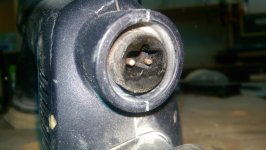smartcarpie
Member
- Joined
- Aug 26, 2011
- Messages
- 62
So a week or two ago I had some issues with the speed fluctuating on my ro125. Just a few seconds at a time, two or three times. I was plugged into a pretty worn receptacle via the Midi, and figured maybe the plug was loose in the old receptacle.
Used it several times since then, didn't notice any issues. Today I sanded 14' of poplar, nothing strenuous, just a quick pass with fine grit to prepare for painting. Same thing again, couple slowdowns.
Thought maybe a temp issue, Sanders just came in from the truck after below zero overnight, and Thought that might have been the original issue.
Then as I was finishing up noticed the burning smell, fried electric. Pulled the plug and found the following. Ideas? Sander, vac, cord issue? I don't believe the plug it cord was very worn. Maybe I'll swap it and give that a shot. Otherwise sander has to go in I guess. Hope I'm still under warranty, gotta check date of purchase.
[attachimg=1]
[attachimg=2]
Used it several times since then, didn't notice any issues. Today I sanded 14' of poplar, nothing strenuous, just a quick pass with fine grit to prepare for painting. Same thing again, couple slowdowns.
Thought maybe a temp issue, Sanders just came in from the truck after below zero overnight, and Thought that might have been the original issue.
Then as I was finishing up noticed the burning smell, fried electric. Pulled the plug and found the following. Ideas? Sander, vac, cord issue? I don't believe the plug it cord was very worn. Maybe I'll swap it and give that a shot. Otherwise sander has to go in I guess. Hope I'm still under warranty, gotta check date of purchase.
[attachimg=1]
[attachimg=2]


